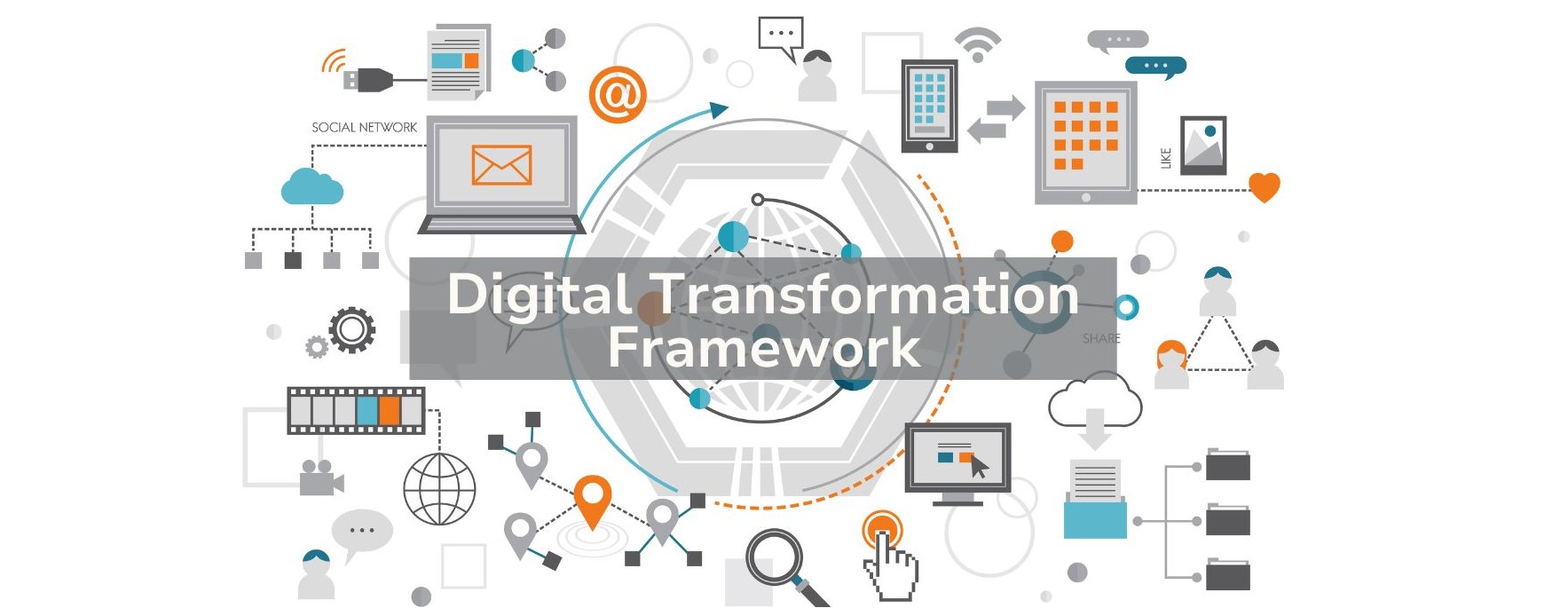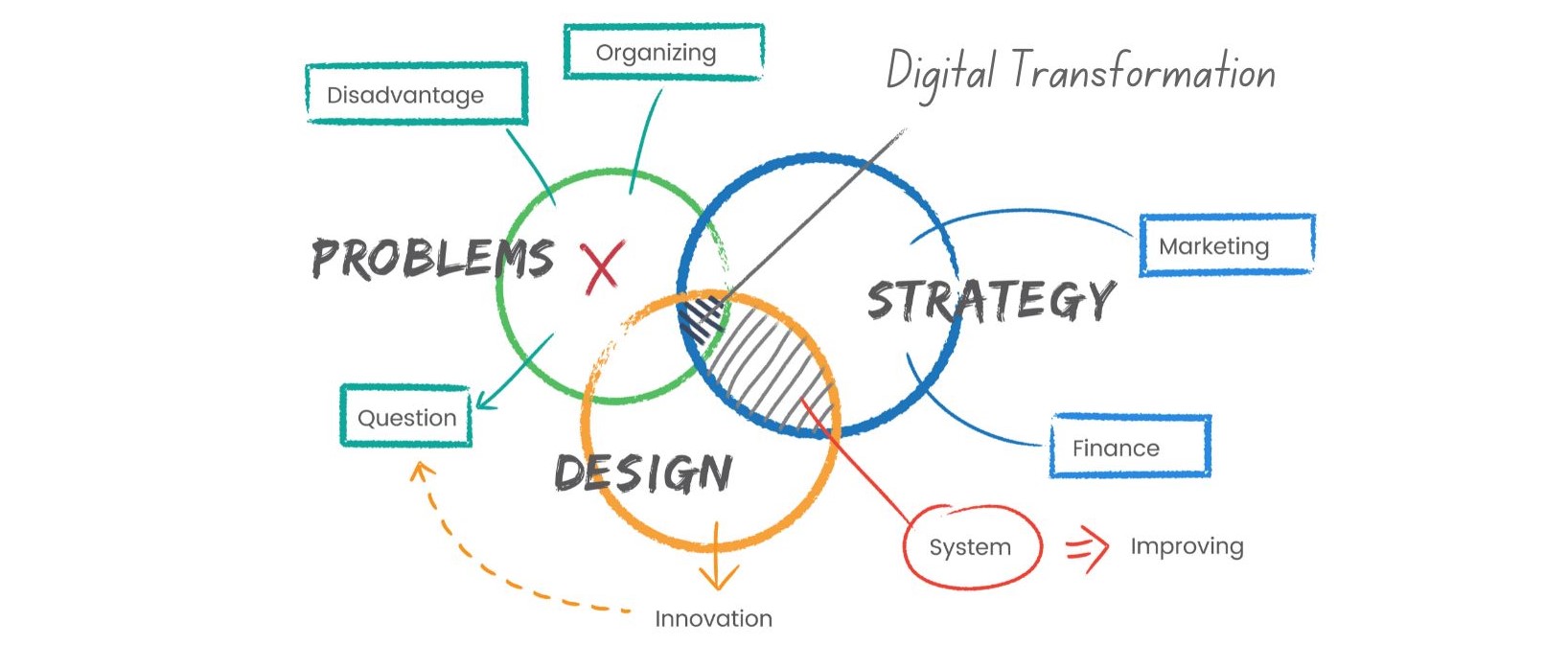According to IDC, there has been a significant increase in investment towards digital transformation, with a compound annual growth rate of 15.5% projected between 2020 and 2023. In 2023 around 75% of companies are expected to possess “comprehensive roadmaps for implementing digital transformation,” a substantial rise from the mere 27% recorded in 2020.
Catalysts for Digital Transformation: A Shifting Landscape
The digital transformation is propelled by various factors, including evolving customer expectations, the rapid progression of technology, shifts within the global market, vulnerabilities within supply chains, and the disruptive presence of competition. This combination compels organizations to make urgent efforts to modernize their technological foundations, operational frameworks, business paradigms, and cultural elements, lest they lag in this dynamic environment.

Transitioning Priorities: From Tradition to Digital Enhancement
The focal point of attention within the business landscape is gradually transitioning from conventional growth strategies to strategic investments in the Digital Transformation framework. This shift is geared towards augmenting performance and ensuring its continuity in the face of profound changes that characterize the current landscape.
Navigating Unprecedented Change: Embracing Innovation
In the contemporary digital epoch, confronting unparalleled change necessitates embracing innovation as a cornerstone of the digital transformation process. Staying ahead of swiftly emerging and highly agile competitors mandates this approach. Emphasizing technology and data utilization emerges as paramount on your strategic agenda, effectively driving customer value. Moreover, fundamental shifts in workplace dynamics compel organizations to undertake extensive and radical restructuring in business models and operational methodologies, all within the framework of the overarching Digital Transformation process.
Unprecedented Drivers: Accelerating Transformation
These influences synergistically propel the pace of digital transformation to unparalleled heights. Notably, 69% of Boards of Directors are expediting their digital business initiatives, deeply embedded within the Digital Transformation framework, in response to the disruptive effects induced by the COVID-19 pandemic. This serves as a testament to the profound acceleration of the digital transformation journey.
The current environment’s diverse forces catalyze the surge toward the comprehensive Digital Transformation framework. Organizations must adapt, innovate, and undergo comprehensive overhauls intricately woven into their digital transformation process to secure competitiveness in this swiftly evolving digital realm.
Digital Transformation – Definition
Digital transformation revolutionizes the operational landscape of companies across diverse industries. Yet, a universally accepted definition for this process remains absent. Regardless of its specific framework—innovation, Agile methodologies, cloud integration, lean practices, or others—the core objective revolves around harnessing enterprise-wide technology and prioritizing enhancing customer experience in decision-making.
According to Gartner, digital transformation is “utilizing digital technologies and supporting capabilities to develop a strong new digital business model.” Others claim that the cross-organizational, strategic business change frequently made possible by digital technologies is focused on enhancing the customer experience.
Digital transformation encompasses extensive dimensions within an organization, extending to its cultural fabric. It mandates the adoption of technologies not for the sake of complexity but to seamlessly integrate systems, automate tasks, harness richer data, ensure transparency, and foster enhanced adaptability to change.
Difference between Digital Transformation, Digitization & digitalization
It’s crucial to differentiate between digital transformation, digitization (converting information into a digital format), and digitalization (utilizing digital technologies to reshape business models and generate new revenue and value-driven opportunities, per Gartner’s perspective). Although digital transformation initiatives often encompass digitization and digitalization endeavors, the outcome of these shifts revolves around delivering customer advantages.
Digital transformation redefines how enterprises function, with customer-centricity at its core, even as it interacts with digitization and digitalization.

Need for a successful Digital transformation framework
Enterprises actively seek avenues to foster innovation, embrace change, and uphold their competitive advantage. In this context, the significance of a robust digital transformation framework has never been more pronounced.
However, achieving triumph in the realm of digital transformation poses considerable challenges. Negotiating a steep learning curve is a daunting task, and this is underscored by the fact that
A staggering 87.5% of enterprises, on average, fall short of achieving their transformation goals.
To bridge this gap, organizations can translate the concept of successful digital transformation into practical reality by implementing an actionable framework. Such a framework empowers them to navigate the future with agility and adaptability, ensuring they remain well-prepared for the evolving landscape.
What is a Digital Transformation framework?
In simple terms, a digital transformation framework is a roadmap that guides an organization’s approach to and journey through digital transformation. It offers a set of fundamental principles and optimal approaches to adhere to throughout the process, emphasizing practical actions rather than abstract concepts.
During the initial phases of digital transformation, the framework aids organizations in recognizing and prioritizing areas that can benefit from digitalization. Additionally, it offers an opportunity to assess the functionality of existing systems and processes.
By providing a structured approach, a digital transformation framework enables organizations to integrate digital solutions into their operations methodically.
After outlining their objectives and identifying the prerequisites for achieving them, teams can strategically plan and execute the necessary steps to progress.
Digital transformation is a continuous endeavor, necessitating an adaptable and open-ended digital transformation framework that can readily align with your organization’s evolving requirements.
Key overarching outcomes to monitor include:
Heightened efficiency
Digital technologies can automate labor-intensive manual tasks and streamline workflows, enabling employees to allocate their efforts toward more impactful responsibilities.
Optimized customer experience
Innovative technological solutions can be harnessed to craft tailored and seamless customer journeys, increasing retention rates and word-of-mouth referrals.
Augmented resilience
Cultivating a digital-first mindset empowers organizations to navigate shifting market dynamics and evolving customer demands with the agility required to swiftly pivot in the face of disruptions and adjust strategies accordingly.
Accelerated decision-making
Through data and analytics, organizations can make well-informed, data-driven choices, yielding improved business outcomes.
Economic advantages
Digital technologies hold the potential to drive cost reductions by automating manual processes that hinder operational efficiency and overall productivity.
Achievements Enabled by a Digital Transformation Framework
A digital transformation framework serves as a facilitative instrument for effecting change. The crux of a triumphant digital transformation framework lies in its actionable strides.
This framework ought to seamlessly steer teams through the intricate phases of the process while keeping overarching objectives at the forefront.
Several advantages stem from having a well-defined framework, including:
- Formulating a precise strategy for digital transformation
- Amplifying attention toward customer behaviors and requisites
- Incorporating cutting-edge technologies to foster data-driven decision-making and improved collaborative efforts
- Cultivating a culture of adaptability and continuous enhancement in the face of swiftly shifting landscapes
By adhering to a digital transformation framework, organizations can adeptly navigate the intricate path of embracing and incorporating digital technologies, ultimately positioning themselves for triumphant outcomes.

Vital elements of a Successful Digital Transformation Strategy
A well-defined strategy should underpin a robust digital transformation framework. Fortunately, given the considerable investments many organizations are channeling into digital transformation, devising a potent game plan need not hinge on guesswork.
Effective digital transformation processes are rooted in data and empirical evidence, leading to the formulation of superior strategies. Consider the following pivotal facets when shaping the path ahead:
Prioritize People
While data and analytics are undeniably valuable, the ultimate beneficiaries of digital transformation are two distinct groups: employees and customers. Empowering employees to contribute to more value-added endeavors while entrusting routine and error-prone business operations to digital assistants grants them the freedom to envisage further enhancements. Simultaneously, surpassing customer expectations through enhanced service and heightened value propels retention and referrals.
Harvest Data
Requisite data takes on diverse forms contingent on an organization’s industry. Regardless of the specific categories, all data should strive for comprehensive coverage and effortless accessibility for pertinent stakeholders. Throughout every phase of a digital transformation framework, data should be a central force, guiding:
- Identification of areas necessitating a change
- Methods for effecting change
- Outcomes of each iterative stage
Lacking a comprehensive grasp of actionable data, the decision-making process in digital transformation can become convoluted and costly.
Craft a Compelling Narrative
Analogous to a natural resource, unprocessed data is the foundation for digital transformation. Yet, data necessitates further refinement to unlock its complete utility.
Employing analytics and modeling can transmute data into coherent narratives, presenting a challenge, proposed resolution, and a review of outcomes or avenues for future iterations.
These data-driven narratives furnish organizations with crucial insights into the triumphs and setbacks of their endeavors, illuminating pathways for enhancement.
Translate into Action
Once stakeholders are accounted for, data is amassed, and insights are gleaned, the time is ripe for implementing alterations.
Organizations can reap advantages from adopting a Strategic Portfolio Management (SPM) solution, fostering the alignment of corporate strategy with executed work. This approach ensures investments are directed toward initiatives that yield maximal value for the company.
Assess Impact and Cycle Back
Changes inevitably trigger evaluations and yield data that is reintegrated into the process. This refined data then fuels the generation of further insights and drives subsequent modifications. A practical digital transformation framework mirrors this perpetual improvement ethos, retaining the necessary flexibility to adapt to shifting business terrains.
Illustration of a Digital Transformation Framework
Digital transformation frameworks are not universally uniform—what proves effective for one organization may not yield similar success for another. Nonetheless, examining the strategies of other businesses can spark innovative concepts and offer the foundational structure for a prosperous framework.
For example, consider wealth management firms facing various digital transformation prospects and challenges, particularly as customer expectations evolve alongside emerging technologies. Here’s a potential digital transformation framework tailored to this industry:
Identify Areas for Enhancement
Commence scrutinizing the current state of the wealth management sector and pinpointing aspects where digital technologies could optimize processes and enrich customer interactions. This could encompass client onboarding, portfolio management, risk assessment, and client correspondence.
Define success
Subsequently, delineate a lucid vision and a set of objectives for digital transformation. These goals could span improved operational efficiency, elevated customer contentment, or augmented revenue generation.
Create a roadmap
Blueprint a roadmap for incorporating digital technologies, aligning it with your organization’s vision and objectives. This roadmap might encompass designated timelines for technology integration, budgetary estimations, and establishing Objectives and Key Results (OKRs) or Key Performance Indicators (KPIs) to gauge advancement.
Implement and Refine
Initiate the digital transformation process while carefully ensuring seamless integration of new technologies into existing workflows. Be prepared to iterate and recalibrate the roadmap as necessitated by evolving circumstances.
Assess and Enhance
Regularly revisit your digital transformation journey, evaluate progress against predetermined KPIs, and identify areas amenable to enhancement. Consistently optimize both processes and technologies to achieve desired outcomes.
McKinsey offers a more streamlined digital transformation framework, referred to as “the 4Ds of a digital transformation.”
- Discover: Forge a business strategy grounded in your objectives and insights.
- Design: Concentrate on the customer journey to discern avenues for cultivating exceptional customer experiences.
- Delivery: Establish a network of collaborative partners capable of amplifying your aspirations.
- De-risk: Mitigate risk by focusing on swift successes that generate momentum and cost savings.
Guidelines for Formulating Your Custom Digital Transformation Framework
Creating your digital transformation framework might appear daunting – and this response is entirely rational. After all, digital transformation is a substantial undertaking.
Numerous third-party partners are enthusiastic about facilitating this journey. In 2022, companies investing in their digital transformation endeavors allocated an estimated $1.8 trillion, reflecting an impressive 18% increase compared to the preceding year.
Anticipate that your rivals will likewise allocate substantial resources to digital solutions as they evolve to meet evolving customer expectations.
Digital transformation is a journey by nearly every business, either already in progress or on the horizon, as consumer behavior evolves toward a preference for digital products and services.
Roughly 70% of organizations either possess a digital transformation strategy or are formulating one.
While it’s impractical to devise a framework universally applicable to every organization, commencing with fundamental digital transformation principles offers a foundation that can be tailored to your unique requirements. Here are actionable pointers for enacting digital transformation. Here’s how:
Precisely Articulate the Digital Transformation Mission Statement
Cultivate a lucid comprehension of the objectives you aim to realize through your digital transformation endeavors. Whether it involves heightened efficiency, enhanced customer retention, increased revenue, or a multifaceted combination thereof, these goals should harmonize with the overarching business strategy.
Involve Stakeholders at Every Tier
Given that digital transformation resonates across all aspects of an organization, active engagement of employees, customers, partners, and other stakeholders is paramount. This engenders commitment and support for the forthcoming changes.
Thoroughly Assess the Organization’s Current Technological Landscape
To adeptly strategize for digital transformation, a comprehensive grasp of the organization’s existing capacities and constraints and the systems and processes necessitating upgrades or replacements is imperative. Moreover, search for opportunities to amalgamate disparate systems into a unified platform to mitigate errors and expedite processing times.
Identify Arenas for Digital Enhancement
Upon grasping the current status, identify domains where digital technologies can be optimally introduced to amplify value and foster revenue growth. This juncture might be apt for exploring potential vendors to ascertain if a singular solution can address multiple issues.
Create a Path
A roadmap is indispensable for orchestrating and executing the requisite changes within a structured, phased approach, which is essential for the success of your digital transformation framework. It should encompass precise objectives, milestones, timelines for each transformation phase, and provision for periodic reassessment and adjustments.
Invest in the technology that is right for you.
Digital transformation necessitates a robust underpinning of technological infrastructure and platforms, encompassing elements like cloud computing, data management systems, and cybersecurity measures. Ensure that your organization invests judiciously in inappropriate tools from the outset, sparing the need for retroactive adjustments.
Prioritize Employee Reskilling
Even the most advanced tech tools are rendered ineffectual when wielded by inadequately skilled employees. Rehiring is costly. Instead, collaborate with employees to facilitate retraining and upskilling, maximizing their proficiency in utilizing digital transformation tools.
Cultivate an Innovation-Centric Culture
Success in a swiftly evolving digital milieu necessitates an organizational culture promoting innovation and continuous learning. Encourage employees to embrace novel technologies and solicit their feedback and suggestions. The most impactful improvement concepts often stem from those engaging with the tools daily.
Sustain an Adaptive Mindset
Digital transformation is an ongoing voyage demanding agility and adaptability. Prioritize agility and iterative work over an unattainable pursuit of perfection.
Commencing with these steps lays the foundation for a digital transformation framework tailored to your organization. Initiate deliberate planning while nimbly retaining the capacity to adapt and adjust within an ever-changing digital landscape.
Enable Your Organization to Progress Ahead
Business landscapes are in perpetual flux, yet achieving triumphant digital transformation need not be overwhelming. Armed with a robust digital transformation framework, you can remain steadfast in your trajectory, empowering your organization to undergo metamorphosis and fuel ingenuity.
This positions your enterprise with the essential resources to effectively respond to shifting customer requisites within a rapidly evolving business environment, all while surpassing competitors in delivering value at an accelerated pace.
Uncover the means to actualize your digital transformation aspirations. Enable your organization to seamlessly link your strategy with execution while curtailing your time to market. Initiate contact with our experts to embark on this transformative journey.



